2013 VOLKSWAGEN JETTA HYBRID fuel
[x] Cancel search: fuelPage 167 of 310

Remove all unnecessary items and unnecessary dead weight from the vehicle.
Remove unnecessary aftermarket components
The more aerodynamic the vehicle, the less fuel it will consume. Aftermarket components such as
bicycle racks reduce its aerodynamic performance.
Therefore, remove unnecessary structures and unused rack systems, particularly if planning to drive at
higher speeds.
See additional tips on using your hybrid drive to help reduce fuel consumption.
Page 173 of 310

WARNING
When powered by the electric motor, the vehicle makes much less noise, both when idling
and driving, than when it is running on the internal combustion engine. It is much harder or
even impossible for the drivers of other vehicles and above all for cyclists, pedestrians, and
children to hear the vehicle when it is running on electrical power.
�x Pedestrians and others can be struck and seriously injured because they cannot hear the
vehicle and tell that it is getting close to them, for instance when you are parking, backing up,
or driving in a low-speed zone where there is likely to be pedestrian traffic.
�x Always watch out for pedestrians, especially small children, cyclists, and others who may
not hear the vehicle or realize that it is about to move or will cross their path of travel.
�x Always be especially careful in residential areas, school zones, and other places where
the speed of motor vehicles is restricted and pedestrians may be at greater risk.
�x Make sure the ignition and the hybrid drive system have both been turned off before
leaving the vehicle.
WARNING
Never leave the vehicle when hybrid drive system indicator lights are still lit. The vehicle can
move if the accelerator is depressed even though the combustion engine has been stopped.
This can cause accidents and severe or fatal injuries.
�x Make sure the transmission is in Park (P) before you get out of the vehicle.
WARNING
Never support the vehicle with cinder blocks, bricks, or other objects to inspect it. The
vehicle could slip or move suddenly and cause an accident with serious personal injury.
WARNING
Never let the hybrid battery get wet. Liquids and other fluids can cause short circuits,
electrical shock, burns, and explosions.
�x Never carry large amounts of liquids or other fluids in the luggage compartment.
�x Always make sure that any containers with liquids and other fluids are properly secured
and tightly closed to prevent leakage during normal driving as well as hard cornering,
braking, and other vehicle maneuvers. Leaking liquids can get into the cover of the high-
voltage battery and the high-voltage cable connections. This can damage the electrical
system and the high-voltage battery.
Never drive until the fuel tank is completely empty. There may not always be enough charge in
the high-voltage battery to get to the next gas station.
Warning and display messages
�
Page 176 of 310

Driving situations Requirements and
conditions Vehicle behavior
Driving in city traffic. – Select a moderate speed. Driving in fully electric mode at this level is
possible with a constant speed of up to
about 37 mph (60 km/h) on a flat road
surface .
– Avoid full acceleration. The fuel consumption is reduced with
moderate acceleration due to higher
efficiency of the combustion engine and
driving in fully electric mode is possible.
– Careful use of the �%�
Page 179 of 310

Sailing
If the accelerator is not depressed and the lever is in position D, the combustion engine is switched off,
even at higher speeds. The vehicle then decelerates slower than conventional vehicles. This feature
can be used to help reduce fuel consumption when you keep traffic conditions in mind and can
anticipate the vehicle's power requirements. The instrument cluster powermeter shows zero.
Brake energy regeneration (Recuperation/charge)
When the vehicle brakes, the electrical energy is generated by the electric motor, which works as an
alternator and charges the high-voltage battery. The same thing occurs while the vehicle is coasting to
a stop or driving downhill.
Energy regeneration is shown in the instrument cluster display or on the Infotainment System screen.
The combustion engine may be switched off automatically in this situation. The instrument cluster
powermeter registers below zero.
Automatic starting - combustion engine
The combustion engine is started automatically in a number of situations.
�x Engine temperature is too low.
�x Catalytic converter temperature is too low.
�x The high-voltage battery requires recharging.
�x High-voltage battery is being charged at high rate when decelerating. The high-voltage battery
cannot absorb any more energy and for this reason the electric motor cannot brake the vehicle. The
combustion engine comes on to help slow the vehicle down (engine brake).
�x Engine hood is open.
�x Leaving the vehicle when the electric motor is still “live”. The status of the electric motor is not
always obvious, particularly when the combustion engine is not running. The combustion engine will
therefore start if the driver's safety belt is unlatched or the driver's door is opened when the
transmission is in Park (P) or Neutral (N) .
Energy flow display
Fig. 113 Energy flow display. A: Instrument cluster. B: Infotainment System.
�
Page 185 of 310

�x Press the CAR Infotainment button.
�x Tap a function key on the screen to view the information described below.
Function key Function
Driv.
data
Since Start Display of fuel consumption, speed, route, travel time, and range
from the time the ignition was switched on until the time it was
switched off.
Long-term Display of total fuel consumption, speed, route, travel time, and
range.
Energy flow Shows the energy flow between the engine, high-voltage battery,
and driving wheels .
Zero Emission Displays the emission-free driving time as a bar graph. Each bar
represents 1 minute of driving. The height of the bar indicates the
proportion of emission-free driving in %.
A full bar, or 100% ⇒ fig. 117 (1), is a 1 minute interval of
emission-free hybrid driving or sailing.
No bar, or 0% (2), is a 1 minute interval driving only with the
combustion engine.
The display shows the emissions for a maximum of 30 minutes.
Tapping Reset resets all values on this graph to zero.
You can always go back to the previously active menu by pressing the �
Page 197 of 310

WARNING
Incorrect tire pressures and/or underinflation can cause sudden tire failure, loss of control,
collision, serious personal injury or even death.
�x When the warning symbol appears in the instrument cluster, stop and inspect the tires.
�x Incorrect tire pressure and/or underinflation can cause increased tire wear and can affect
the handling of the vehicle and stopping ability.
�x Incorrect tire pressures and/or underinflation can also lead to sudden tire failure,
including a blowout and sudden deflation, causing loss of vehicle control.
�x The driver is responsible for the correct tire pressures for all tires on the vehicle. The
recommended tire pressure values are listed on a sticker inside the driver door .
�x The TPMS can only work correctly when all tires on the vehicle are filled to the correct
cold tire inflation pressure.
�x Using incorrect tire pressure values can cause accidents or other damage. Always inflate
the tires to the correct specified cold tire pressure values for the tires installed on the vehicle.
�x Always maintain correct cold tire inflation pressure so that TPMS can do its job.
�x Always inflate tires to the recommended and correct tire pressure before driving off.
�x Driving with underinflated tires causes them to flex (bend) more, letting them get too hot,
resulting in tread separation, sudden tire failure, and loss of control.
�x Excessive speed and/overloading can cause heat build-up, sudden tire failure and loss of
control.
�x If the tire pressure is too low or too high, the tires will wear prematurely and the vehicle
will not handle well.
�x If the tire is not “flat” and you do not have to change a wheel immediately, drive carefully
and at reduced speed to the nearest service station to check the tire pressure and add air as
required.
�x When replacing tires or wheel rims on vehicles equipped with TPMS always read and heed
the information and all WARNINGS regarding , Tires and wheels.
�x The Tire Pressure Monitoring System must be recalibrated using the SET button whenever
you remove and remount or change any wheel or tire on the vehicle, even if the reinstalled or
replacement wheels and tires are identical to those that were removed and even if the tire
pressure does not change or! Bookmark not defined..
WARNING
Improper use of the SET button can cause the TPMS to give false warnings or to give no
warning despite dangerously low tire pressure or! Bookmark not defined..
Underinflation increases fuel consumption and tire wear.
Do not rely solely on the Tire Pressure Monitoring System. Check your tires regularly to make
sure they are properly inflated and have no signs of damage, such as punctures, cuts, cracks, and
blisters. Remove any objects that become embedded in the tire tread but have not penetrated into the
body of tire itself.
When you take delivery of the vehicle, the Tire Pressure Monitoring System is calibrated for the
factory-recommended cold tire inflation pressure for the tires on your vehicle, as shown on the label
inside the driver door .
�x The system must be recalibrated using the SET button whenever you remove and remount or
change any wheel or tire on the vehicle, even if the reinstalled or replacement wheels and tires are
Page 207 of 310

Refueling
�
Page 208 of 310

WARNING
Even if empty, portable fuel containers can leak and cause a fire and serious personal
injuries, especially in a crash.
�x For your safety, we strongly recommend that you do not travel with a portable fuel
container in your vehicle.
�x If, under exceptional circumstances, you must transport a portable fuel container, please
observe the following:
– Never fill a portable fuel container while it is anywhere in or on the vehicle (for
example, in the luggage compartment or on top of the luggage compartment lid). Static
electricity can build up while filling and can ignite fuel vapors, causing a fire.
– Always place a portable fuel container on the ground before filling. Never spill fuel
inside the vehicle or luggage compartment. Fuel vapors are highly flammable.
– Always keep the filler nozzle completely inside the portable container before and
during filling.
– If filling a portable container made of metal, the filler nozzle must always be in contact
with the container. This will help prevent static electricity from discharging and causing a
fire.
– Always observe local and state or provincial laws about the use, storage, and
transportation of portable fuel containers.
– Make certain that the portable fuel container meets industry standards, such as
ANSI/ASTM F852-86.
NOTICE
�x Remove fuel spills from the vehicle immediately to help prevent damage to the paint, tires,
and wheel housings.
�x Refueling with gasoline when your vehicle has a diesel engine or refueling with diesel fuel
when your vehicle has a gasoline engine can cause very serious and expensive engine and
fuel system damage that is not covered by any Volkswagen Limited Warranty.
�x If you put any amount of incorrect fuel in the fuel tank, do not start the engine under any
circumstances. Immediately contact the nearest authorized Volkswagen dealer or authorized
Volkswagen Service Facility for assistance. These fuels contain substances that can severely
damage the fuel system and the engine if the engine is started.
NOTICE
If the fuel tank venting system malfunctions and the fuel tank cannot be properly vented before
refueling:
�x Gasoline fumes can escape from the fuel filler neck, resulting in temporary odors.
�x The fuel nozzle may shut off during refueling and it will take longer to refuel the vehicle.
Only in this situation can you continue to carefully refuel your vehicle after the fuel nozzle
shuts off.
�x See your Authorized Volkswagen dealer or authorized Volkswagen Service Facility to have
your vehicle checked.
Fuels can pollute the environment. Spilled fuel must be collected and disposed of properly,
following all applicable environmental regulations.